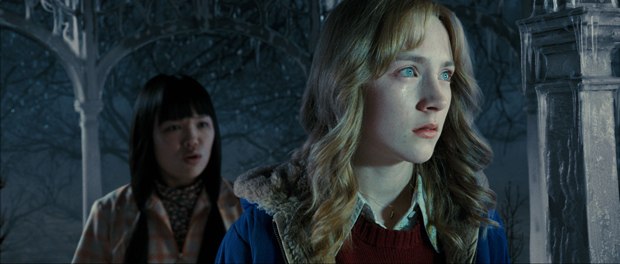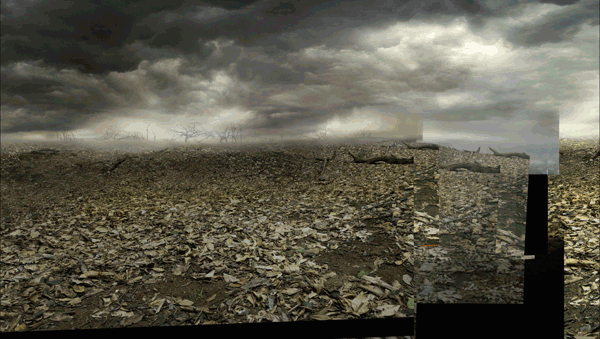Weta Digital describes the artistic challenge of pulling off Peter Jackson's vision for The Lovely Bones.
Check out the Lovely Bones trailer at AWNtv!
As Peter Jackson told us earlier, his vision for Susie Salmon's afterlife in The Lovely Bones (which Paramount Pictures opened wide last weekend) was a surreal, in-between journey to heaven predicated dreams and metaphoric symbols. A house in the dead cornfield represents her murderer, Mr. Harvey; the blooming flower suggests Susie's life force and her ability to communicate with her father; the Gazebo in the barley field signifies unfulfilled love, with the field turning to mush as she runs toward it.
Interestingly, the vfx challenges for Weta Digital were more artistic than technical, even though the CG imagery of the In-Between world necessitated abandoning the laws of physics.
"It was an interesting process because you're starting out with a blank canvas for almost every shot," explains Joe Letteri, senior visual effects supervisor. "Peter did have some idea about things he wanted to see and we refined those and worked them into the sequences of shots. But it was very much kind of an unknown what this was supposed to look like and how it presented itself, because we wanted you to get the sense that this was being constructed around Susie for her benefit. But it's not something that she's making up or can will to existence. It's like a dream, so we kept trying to find all the right touchstones, if you will; little things from her life that would turn into this bigger landscape. So the snow globe becomes this big snowcapped mountain that she's sled riding on. It was very creative. Michael did hundreds of pieces of artwork to get through it all -- and it was almost like a great big jigsaw puzzle: putting the elements around in different orders and trying the shots in different ways, and Peter would work on the cut and it would change a little bit and we'd have to rework the shots and it was really a very iterative process the whole way through.
"The most interesting thing was how to build a narrative out of these sequences -- what the flow was like because this was so dream-like. The idea of what her soul is doing -- this comet-like effect. But then she's not ready to go where she's supposed to. How does she stop herself? The reaching out and grabbing onto a bit of a flower, a bit of a landscape: Was it always there or did it come into being because she needed it to be there? And then it quickly turns into seeing the whole grassy hill revealing itself and the whole world around her. So it was really coming up with those progressions of ideas that told the story but also gave you the feeling of being in the place."
For Michael Pangrazio, visual effects art director, it was certainly a far cry from the photoreal and quite a fulfilling, if solitary, experience. "It was the most difficult thing that I've ever done to fuel the imagination of Peter and Fran. And the one thing they said was they wanted natural phenomena and not a lot of architecture. I always thought was a great idea to project her mentality on this environment and make these scenes reminiscent of what a 14-year-old girl would think like, and that's what I tried to dig down and try to find, which is hard because I'm not a 14-year-old girl.
"Knowing that the basis of this was surrealistic to begin with, the way I approached it was to read the script and to think illogically. Peter told us to think illogically. At one phase, he said don't even care if it doesn't make sense -- just create images and ideas. And then he filters them out and picks and chooses."
However, it helped listening to The Lovely Bones book on tape during script development. "I would look for images that struck me as beautiful or appropriate and with up to 15 of them like a chef combine the ingredients and synthesize them into something. As they started sending through script pages I would create artwork and send it through. This would evoke more ideas so as script ideas evolved so did the look of the film. Key sequences were mapped out in this way and built upon. From the very beginning on certain points we were creatively in sync."
Not surprisingly, Salvador Dali was the biggest influence: helping Pangrazio attempt to understand what makes something surreal, unearthly or unnatural. He says it's a combination of elements that are impossible together: scale, gravity and color. "The whole process was a real creative search," he echoes. "What do you do with this philosophical world that most people, at least here in the West, have a preconceived idea in their opinion of what it is. There are repeated themes, which are important for the audience to ponder and figure out that there's a thread that adds up to a logical payoff. It's a mystery for Susie too to figure out. It's part of the angst of the whole story."
According to Charlie Tait, compositing supervisor, instead of making things look natural and photoreal, the surreal nature of the imagery in The Lovely Bones required a different challenge: "For example, when you see day and night in the same image at the same time, we'd have to find how the elements could all be brought together convincingly and elegantly."
Letteri says the destruction of the ships in the bottle posed an additional challenge: "Early on, Susie and her father [Mark Wahlberg] work on ships and bottles. It's a passion they share. Her father on earth is remorseful; and falling apart. His actions of destroying what they built together in her In-Between [world] are also represented as the floating bottles start breaking. What is happing in the real world is reflected in the in between and vice versa. The two worlds run parallel."
Indeed, this effects-heavy moment represents a turning point in Susie's In-Between experience. While the scene starts out calm and serene, on a beautiful beach, it ends in violence and destruction.
"This scene initially took shape through a process of previsualization during the film's pre-production phase: taking ideas described by Peter and working them into low-res digital animation," explains Matt Aitken, digital visual effects supervisor. This gave us a blueprint for the scene.
"During production aerial plates were shot for use as backgrounds in some shots, these were shot at Wharariki Beach in a remote part of New Zealand's South Island. We were also provided with blue screen elements of Susie running which were shot in the studio. Wide shots used a digital Susie which we could track into the background plates.
"Creating the digital ships and the bottles containing them involved balancing the scale of the ships with a design that evoked the miniature ships that Susie had enjoyed making with her father. The ships we built were more complex than the miniatures, which would have been too simple visually, but lacked most of the design features of a fully-rigged sailing ship, which would have worked against establishing the connection. For this reason also the ships have giant paper sails rather than flapping cloth sails. We created bottles made from antique glass with all its imperfections to echo the miniatures once again and add realism.
"When the bottles smash apart we had a choice between running the destruction as a physical simulation, or breaking the bottles 'by hand' and animating the flying pieces with keyframe animation. We chose the latter for the main pieces of glass because it offers a high level of control over the shape and detail of the destruction. Peter had very specific notes on how the bottles should break: bottle necks rolling on the beach, jagged pieces hanging off bottles, to add to the sense of violence. Smaller shards of glass which fly out when the bottles shatter and add to the explosive nature of the collisions were animated with dynamic simulations, where the physical properties of the collision are modeled in the computer and a mathematical simulation calculates the path of each shard. This enabled us to add a lot of fine detail to the effect."
In all, there were 663 vfx shots, most of which were actually earthbound and "invisible," such as placing a cornfield behind the suburban street where Susie and her family live, creating a sinkhole in a rural field and adding exteriors to the house interior sets.
"We had to create a sinkhole that grows throughout the course of the film," adds Christian Rivers, visual effects supervisor. "The film starts with the Salmon family dumping their old refrigerator. At the end of the film, Mr. Harvey dumps the safe that contains Susie's body into the larger sinkhole. The sinkhole…is entirely digital."
As Weta progressed throughout the vfx work, the supervisors didn't always understand where it was headed and how it would all look when it was completed, but on the night they finished and delivered the last shot, Tait made a slide show of stills from his favorite scenes. He remembered "the history and struggles of each and every shot as I looked at them. When I played the slideshow, it was absolutely clear where we'd been taken and thrilling to see how seamlessly all these surreal ideas fitted together to make such a daring and original vision, so appropriate to Susie, and so strikingly beautiful."
Bill Desowitz is senior editor of AWN & VFXWorld.












